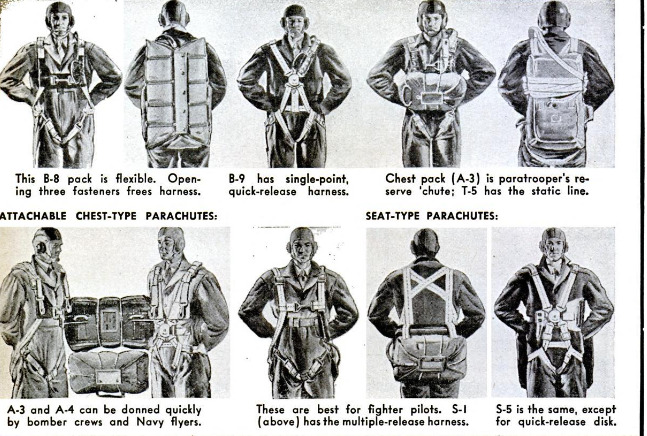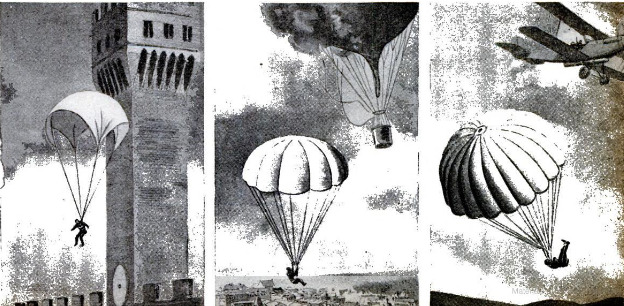-
Title (Dublin Core)
-
From stuntman paratrooper How armies hit the silk
-
Article Title and/or Image Caption (Dublin Core)
-
From stuntman paratrooper How armies hit the silk
-
extracted text (Extract Text)
-
THE airborne forces that parachuted to
earth beyond the watchers on the Rhine
this spring mushroomed out of an idea that
is older than Uncle Sam. The parachute
vas invented before the airplane, but, until
after World War I, parachuting was mainly
a showman’s stunt, on a par with sword
swallowing.
The French flyer who saw a German pop
out of a burning plane and float gently into
a storm of bullets in no man’s land in 1917
was flabbergasted. His generation of air-
men had felt that anyone who was seriously
interested in ways of deserting his ship was
a sissy.
But the parachute now ranks with the
lifeboat, the first-aid kit, and the chariot as
‘one of mankind's super-duper ideas. It is no
longer a mere fire escape from the heavens
for pilots; it can be used now to deliver al-
most anything that can be taken up in a
plane. Electrically driven conveyor belts
dump cargo bundles into thin air from some
planes, and doors were cut in both sides of
the C-46 Commandos that flew over the
Rhine, so that two columns of paratroops
could march out simultaneously and descend
in double file.
Such surprising assaults from the sky
stem from scientific research that was
started during the last war—and continued
after the Armistice.
Nearly five centuries ago Leonardo da
Vinci drew a picture showing how a man
with “a tent of calked linen” could “let him-
self fall from any great height without
danger to himself,” and between 1780 and
1800, when men began to go up in balloons,
some of them came down this way.
The first parachutes had rigid frames and
were far from perfect mechanically. Pro- |
fessional daredevils devised nonrigid para-
chutes, beneath which they hung on trapeze
bars. The speed of airplanes increased the
hazards. Capt. Albert Berry made the first
successful drop from an airplane in 1012
with a ‘chute that had been packed in a
metal cylinder under the planes fuselage.
But the First World War was over before
any country had developed a ‘chute that
could be guaranteed to open on leaving an
airplane.
Interest waned considerably when peace
came, but Major E. L. Hoffman and a num.
ber of other Americans persisted. Leslie
Irvin saw Houdini produce a huge flag from |
a tiny container, and thought of making a |
parachute out of silk and squeezing it into a |
small pack. Other noteworthy features of
the parachute that he produced were a sim-
ple rip cord and a pilot parachute to pull |
out the main canopy.
“PLANE FAILED, PARACHUTE
WORKED,” Jimmy Doolittle happily wired
the Irving Air Chute Company 14 years ago,
after a thrilling escape from a damaged
plane in the National Air Races. That four- |
Word message was a climax to years of re
search, including more than 50,000 tests with
dummies. And the same four words now |
summarize more adventures than there's
paper enough to print.
The parachutes used nowadays are thor-
oughly reliable mechanisms. Both the “free” |
‘chutes, used in emergency descents, and the
“automatic” type, worn by paratroopers
and pulled open by a canvas-web “static
line” attached to the plane, are trustworthy
conveyances. Unusual conditions and human
errors still result in mishaps, but young
pilots now are told emphatically:
“Don’t take chances. Hit the silk if some-
thing goes wrong. We can build ten of these
planes in the time it takes to train you.”
This advice has been stressed because,
even after airmen were ordered to wear
parachutes, flyers persisted in an attitude
comparable to that of sailors who refuse to
learn how to swim. The importance of the
know-how is better realized now. Well-
trained paratroops have been injured in
leaps only about one sixteenth as often as
flight crews. Such statistics prompted the
AAF Office of Flying Safety to wage an ex-
tensive educational campaign among air
personnel in 1943, and brightly colored post-
ers now hang in air stations to remind com-
bat flyers of the correct way to descend be-
neath a blossoming awning.
‘To get out of a stricken, 400-mile-an-hour
fighter with an enclosed cockpit, or a big,
complex, misbehaving bomber, a man still
may need luck as well as a cool head and
technical skill. Most combat planes now are
fitted with automatic door or canopy re-
leases, some of which are spring-assisted
and actually fly off. Bombers have escape
hatches forward and aft, and the gaping
hole of the bomb bay may be used in a
pinch. But it pays 1945 candidates for mem-
bership in the Caterpillar Club to keep in
mind “three A's”:
Altitude: “Am 1 high enough to have
time for the "chute to open? Paratroops are
dropped from low but carefully predeter-
mined altitudes. If T'm very high, I must
connect the oxygen bottle on my leg, or
make a free fall until I reach ‘breathing’
air.”
Attitude: “The best attitude for a bail-
out is upside down. Can I roll the plane over
and fall out? If the ship is diving, I must
brace my feet lest I be thrown forward
when I unbuckle the safety belt. If the ship
is spinning, T'd better go out the correct
side—toward the inside of the spin, So the
tail will be swinging away from me.”
Air Speed: “Will I be going 400 miles an
hour when I leave the plane? That's too
fast. ‘Body speed’ in a normal free fall be-
fore a ‘chute opens is only about 125 miles an
hour. Can T fall free until T have slowed
down nearer to that speed?”
As he falls away, the wise parachutist
keeps his legs together to avoid tangling the
harness and risers when he pulls the rip
cord. A jolt tells him when the ‘chute opens;
if he finds himself swinging too much, he
steadies the magic carpet above him by
pulling at the shrouds on the high side of
each swing. He then looks downwind for
a likely landing spot, and grasps the
shrouds to swing the ‘chute so that he is
facing the way the parachute is drifting.
If trees or other obstacles loom in his path,
he sideslips by pulling down on the shrouds
on one side.
As he hits the ground, he pulls up strongly
on the risers. He lands with his feet to-
gether and his body and knees slightly bent.
He doesn't try to stay on his feet, but tum-
bles, taking the shock of the roll on his
shoulders and buttocks. A man coming down
straight, without oscillating, in a standard
24-foot parachute hits the ground about as
hard as though he had jumped off an eight-
foot wall.
If the wind is high, the well-trained para-
chutist unbuckles the hagness leg straps be-
fore touching the ground, unsnaps the chest
buckle the instant he lands, to free himsel
from the dragging ‘chute. He takes pains,
however, to save his ‘chute if possible, by
spilling the wind out and collapsing it as
s00n as he has landed—because a parachute
is often as nice to have on the ground as in
the air.
Stranded airmen have used their para-
chutes to make tents, clothing, bandages,
slingshots, fish lines, snowshoes, and scores
of other handy items. One sergeant, to at-
tract the attention of planes searching for
him, touched a match to the rubberized
horsehair cushion of his ‘chute, and the black
column of smoke that it sent up led to his
rescue.
‘Pure silk parachutes are considered best,
especially in northern climes, and some are
still being made in this country from Japa-
nese silk bought before the war. But many
parachutes now ‘are made of nylon, or ace-
tate fabrics such as celanese, milanese, or
rayon. Cargo parachutes are made of mer-
cerized cotton and rayon, and those for
flares and fragmentation bombs of specially
processed paper. Experts at the Parachute
Laboratory of the Materiel Command at
Wright Field, Dayton, Ohio, have developed
dozens of different kinds and sizes of ‘chutes.
Both seat-pack and chest-pack parachutes
are available that can be attached to a
man's harness by snap buckles in a Jiffy.
Bomber crews and Navy airmen wear the
harnesses that go with these packs. They
can walk around the whirling propellers on
a crowded carrier deck, or move about in-
side a plane, without being encumbered with
packs, yet can hook them on quickly when
they need them.
Food and other necessities are stored in
some modern military parachutes. The
AAF B-4 Basic Emergency Kit is zippered
into a canvas case which is attached to the
‘chute harness in place of the back or seat
pad normally worn for comfort. This outfit
includes a_feather-stuffed poncho-quilt, a
folded machete, and a first-aid package as
well as a small supply of emergency rations.
The Navy has a similar kit that may be
substituted for the harness cushion, and
also a pararaft for carrier pilots. The in-
flatable raft is made of rubberized nylon
and stowed in a small roll on top of the
parachute pack. The raft is only large
enough for one man, but has a protective
cover and folded paddles.
Rescue planes can spill more food, medi-
cines, and supplies on men downed on land
or sea. A Tropic Rescue Kit contains items
helpful to men lost in jungles or deserts,
and a Marine Rescue Kit has a canister full
of supplies for castaways.
Our Army learned a lot about packaging
and parachuting provisions from the U. S.
Forestry Service, whose asbestos-clad
“smoke jumpers” were being supplied by
parachute in fire fighting before the war,
Orange ‘chutes are used in the arctic, and
an orange flag pops up from some of the
containers used, to help men find the sup-
plies dropped for them. Other colors are
used in the tropics and, to facilitate the re-
covery of parachuted cargoes from trees, a
weighted line dangles from each bundle.
This line is about 75 feet long and brightly
colored, with a four-pound steel ball on one
end to carry it through foliage.
The paratroops of World War II have
given the most spectacular demonstrations
of Leonardo da Vinci's theory, but they are
still lightweights compared with other mili-
tary forces. Brig. Gen. Wiliam D. Old,
Commanding General of the I Troop Car.
rier Command, recently predicted “aerial de-
livery of standard ground-force divisions.”
“The armies of the future,” he warns,
“will not be as concerned with the frontiers
of enemy nations as with vital spots within
the nation itself. Thus, entire air-trans-
rorted armies may be landed in the heart
of the enemy's homeland and wage their
war from within—supplied, equipped, and
reinforced entirely by air.”
-
Contributor (Dublin Core)
-
James L. H. Peck (article writer)
-
Language (Dublin Core)
-
eng
-
Date Issued (Dublin Core)
-
1945-06
-
pages (Bibliographic Ontology)
-
128-135
-
Rights (Dublin Core)
-
Public domain
-
Archived by (Dublin Core)
-
Sami Akbiyik
-
Marco Bortolami (editor)
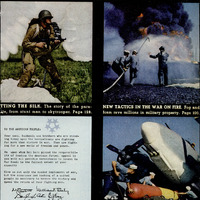 Popular Science Monthly, v. 146, n. 6, 1945
Popular Science Monthly, v. 146, n. 6, 1945
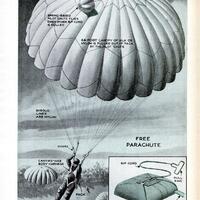 content.jfif
content.jfif Screenshot 2023-01-18 150117.png
Screenshot 2023-01-18 150117.png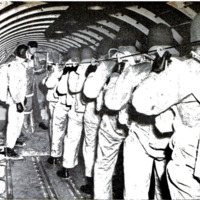 Screenshot 2023-01-18 150131.png
Screenshot 2023-01-18 150131.png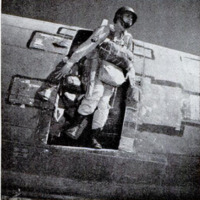 Screenshot 2023-01-18 150142.png
Screenshot 2023-01-18 150142.png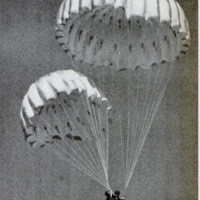 Screenshot 2023-01-18 150152.png
Screenshot 2023-01-18 150152.png Screenshot 2023-01-18 150205.png
Screenshot 2023-01-18 150205.png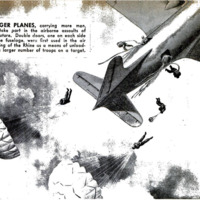 Screenshot 2023-01-18 150217.png
Screenshot 2023-01-18 150217.png Screenshot 2023-01-18 150228.png
Screenshot 2023-01-18 150228.png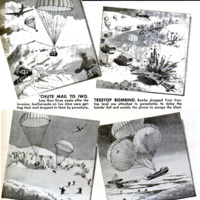 Screenshot 2023-01-18 150243.png
Screenshot 2023-01-18 150243.png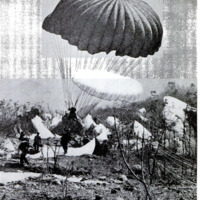 Screenshot 2023-01-18 150255.png
Screenshot 2023-01-18 150255.png





